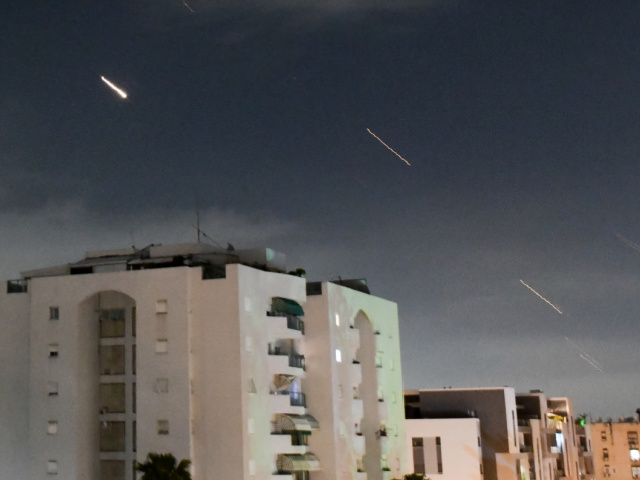Iran’s state-controlled PressTV on Monday quoted officials from the Islamic Revolutionary Guard Corps (IRGC) who claimed they launched “hypersonic missiles” at Israel on Saturday night and that the fast-moving weapons were able to evade Israel, the U.S., and all of their allies to strike their targets in Israel.
PressTV claimed Iran is “among the few countries that possess the technology to produce hypersonic missiles, which can travel at stunning speeds and hit their targets with great precision.” Saturday night was supposedly the first time Iran has fired these advanced missiles at live targets.
The report quoted Iranian Armed Forces chief of staff Maj. Gen. Mohammad Baqeri’s claim on Sunday that Iran “hit a large intelligence base in the occupied lands and Israel’s Nevatim Airbase, from where an F-35 jet took off to target Iran’s diplomatic premises in Damascus.”
Baqeri said Iran’s airstrikes “reached their goals” as Israel’s vaunted Iron Dome defense system “failed to deal with the Iranian missiles and drones properly.”
The actual evidence from eyewitnesses and statements from military forces across the Middle East directly contradicts these claims. Iran’s attack was almost completely intercepted by Israel, the United States, and allied ground and air units, including Jordan and possibly other Middle Eastern military powers.

Israeli Iron Dome air defense system launches to intercept missiles fired from Iran, in central Israel, Sunday, April 14, 2024. (AP Photo/Tomer Neuberg)
“Iran initiated an attack against Israel, launching over 300 threats of various types. The Iranian threat met the aerial and technological superiority of the IDF, along with a strong fighting coalition,” said Israeli Defense Forces (IDF) spokesman Rear Adm. Daniel Hagari on Sunday.
“99 percent of the threats launched towards Israeli territory were intercepted – a very significant strategic achievement. Of approximately 170 unmanned aerial vehicles (UAVs) that Iran launched, zero crossed into Israeli territory,” he said.
“From the more than 30 cruise missiles Iran launched, none crossed into Israeli territory. Out of over 120 ballistic missiles, only a few crossed into Israeli territory, with the rest being intercepted,” he said.
Hagari added that the cruise missiles that made it into Israeli airspace came down near Nevatim Air Force Base but caused only “minor damage to infrastructure.”
“Iran hoped to incapacitate the base and thus impair our aerial capabilities, but it failed. IAF aircraft continue to take off and land from the base and depart for offensive and defensive missions,” he said.
Iran said its attack was retaliation for Israel allegedly bombing the Iranian consulate in Damascus and killing several high-ranking officers of the IRGC, which is a designated terrorist organization. Israel has not formally taken responsibility for the bombing, much less divulged what kind of jet was used or where it might have launched from.
Israel does have an inventory of F-35 Lightning fifth-generation fighters, designed by Lockheed Martin in cooperation with a number of U.S. allies. There are F-35s based at Nevatim, which appears to have been Iran’s major military target.
Iran’s strategy was evidently to overwhelm Israel’s defenses with a huge swarm of relatively slow-moving drones, then punch through the chaos with fast-moving ballistic missiles that need only about ten minutes to reach their targets after launch.
According to IDF officials, Iran’s strategy was thwarted by the Arrow-3 anti-missile system, a project jointly developed with the United States and used in combat for the first time in November. The Arrow interceptor missile has proven highly effective against ballistic missiles launched by the Houthi insurgents of Yemen, who get their weapons from Iran.
Israel has developed a multi-layered interception system, under which Iron Dome takes out drones and short-range missiles like the highly inaccurate terror rockets favored by Hamas and other Iranian proxy forces, while the Arrow, the U.S.-made Patriot anti-missile system, and warplanes like the F-35 intercept larger missiles at greater distances and higher altitudes. The Arrow can hit incoming ballistic missiles while they are still in space, as appears to have happened on Saturday night.
The IDF filled in the gap between Iron Dome and the Arrow with David’s Sling, which saw action for the first time in May 2023 during a previous clash between Israel and Palestinian terrorists. David’s Sling, which was co-developed with Raytheon and introduced in 2017, is effective at intercepting targets between 25 and 185 miles away.
David’s Sling uses a missile known as the Stunner, which distinguishes itself from many other interception systems by taking a “hit-to-kill” approach — guided by extremely sensitive radar and advanced electronics, it directly impacts incoming missiles, rather than detonating near them and seeking to damage them with shrapnel.
Among other benefits, this can reduce the amount of debris falling from the sky during successful intercepts, and it reduces the chances of a damaged ballistic missile falling to earth with its warhead intact.
Iran has a huge arsenal of missiles and drones, but whether any of them qualifies as a true hypersonic missile or not is questionable. In the days before the attack, Iranian state media showcased nine missiles that could supposedly reach Israel from launch sites in Iran. Only one of them, the Fattah-2, was billed as hypersonic, and it is still under development.
The Fattah-2 supposedly consists of a solid-fuel booster rocket that launches into space, then deploys a hypersonic glide vehicle (HGV) with a liquid-fueled engine that delivers the warhead to its target.
Iran ceremonially unveiled the Fattah-2 in November 2023 at an exhibition that also ostensibly included a new generation of nearly unstoppable drones. Given how poorly Iran’s drones appear to have fared on Saturday night, there is good reason to doubt its claims of world-class hypersonic missile technology.
North Korea, which has reportedly worked closely with Iran on missile development, claims to have test-launched a similar weapon in April. North Korea’s rocket only covered about 375 miles before it splashed down in the ocean between South Korea and Japan. Independent analysts have seen no evidence that North Korea has a deployable medium — or long-range hypersonic missile yet.

Israeli Prime Minister Benjamin Netanyahu, right, and US Ambassador to Israel David Friedman watch a video which shows the launch of the Arrow 3 hypersonic anti-ballistic missile during a cabinet meeting in Jerusalem Sunday July 28 2019. (Menahem Kahana / POOL via AP)
A true hypersonic weapon is capable of sustained flight at over five times the speed of sound, or about 4,000 miles per hour, which would make them difficult to intercept or even monitor. The current world leader in hypersonic technology is probably China, although Russia has a history of making boisterous and improbable claims about the supernatural capabilities of its Zircon hypersonic cruise missile.
The Zircon can supposedly reach eight times the speed of sound, moving so fast that it generates a plasma cloud that absorbs radar and radio waves. Russian leader Vladimir Putin has claimed the Zircon is undetectable and unstoppable, even with the latest American or Israeli defense technology. Putin also claimed the Zircon “has no analogues in any country in the world.”
Ukraine said in early April that Russia has attacked it with sea-launched Zircon missiles five times since the beginning of 2024, plus 11 slower-moving Kinzhal hypersonic missiles. The Zircons and Kinzhals did not appear to be game-changing super-weapons, although Russia has launched so much ordnance against Ukraine that it is difficult for outside observers to judge the performance of a handful of missiles.
Ukraine reportedly managed to shoot down over a half-dozen Kinzhals with U.S.-supplied Patriot missile batteries, which burst the hype bubble around hypersonics in the eyes of some defense analysts. The U.S. military does not seem terribly impressed by the performance of its own hypersonic glide test vehicles; rather than falling behind in a superpower arms race, the U.S. seems to have shifted its focus to improving its defense systems until they can reliably intercept hypersonic missiles.
Nothing Iran launched against Israel on Saturday displayed anything like the capabilities Russia has boasted of for its hypersonic weapons. In fact, U.S. officials said on Monday that about half of the missiles Iran launched malfunctioned in flight or failed to clear their launch pads.
According to those U.S. sources, a grand total of five Iranian ballistic missiles reached Israeli territory, four of them targeting the Navatim Air Force Base. The missiles struck two empty aircraft hangars and a single runway. The fifth missile struck at a radar site in northern Israel but missed.

COMMENTS
Please let us know if you're having issues with commenting.